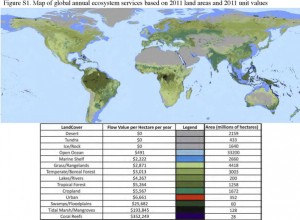To quote the Notorious BIG, “It’s all about the Benjamins, BABY!”
That quote unfortunately holds true in many walks of life, and is especially applicable to this weeks FSF where Dr. Costanza, from Australian National University, and a number of colleagues puts a price tag on the world’s natural environment. Some of you are probably thinking, “Dude, that’s old news!” In summary, yes, this is old news.. sorta.

Back in 1997, Costanza and friends wrote an influential paper valuing the worlds ecosystem services. It was met with varied reception. Some economist lamented the paper for bad economics and some conservation biologist argued it was a bad way to approach conservation. However, many people applauded Costanza et. al for their approach and it led to changes in the way many governments viewed and valued their natural resources. A number of governments, from Costa Rica to the United Kingdom, started to take the value of ecosystem services into account when they planned environmental policies.
Earth… you expensive!

So why am I bringing up a paper from 1997? Well that group has revisited their assessment of the value of global resources and updated their estimate based on new findings about ecosystem value. In 1997 Constanza and his team estimated the value of ecosystems worldwide was ~33 trillion dollars. To put that in perspective, that was more than double the GNP of every country on the Earth back in 1997. Seventeen years later, Constanza and his team estimate that the original value was far too low, and that the true estimate of global ecosystem value is likely 3 times as much as what they previously thought.

To be honest, that is a mind boggling and humbling assessment about the value of the environment. While people may have their criticisms of this approach, converting ecosystems services into a tangible value (despite the imprecision) is a good starting point to help people conceptualize the importance of these systems. As an example, to put into some perspective the value of a single ecosystem. After Hurricane Katrina, the Army Core embarked on a 14.5 billion dollar project on a massive network of flood walls and levees to protect New Orleans from coastal damage. The cost for this project does not account for maintenance and upkeep, indicating the true cost will be far higher than the initial expenditure. You know what else protects coast from storm damage? Coastal marshes! Coastal marshes absorb the wind energy and waves of storms, weakening their impact farther inland. And oddly enough, these systems rebuild and maintain themselves.
Dr. Costanza’s method is a powerful approach that provides us with an avenue to see just how much we depend on nature — and just how much of it we’re destroying.

You can see the original research article published in the journal Global Environmental Change.